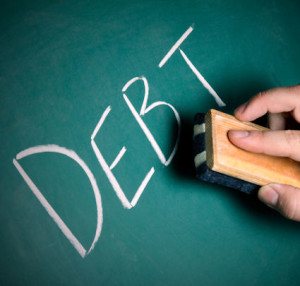Chapter 7
Chapter 7 Bankruptcy Explained
 Chapter 7 bankruptcy is a way for individuals who cannot afford to pay their creditors to obtain debt relief. This type of bankruptcy is sometimes referred to as a straight bankruptcy or liquidation bankruptcy. In Chapter 7 bankruptcy, debtors list all of their assets on schedules filed with the bankruptcy court. Values are assigned to these assets. Each state has a group of laws called exemptions, which can be used to protect property from creditors. Debtors use these exemptions to protect their interest in the assets listed in their schedules.
Chapter 7 bankruptcy is a way for individuals who cannot afford to pay their creditors to obtain debt relief. This type of bankruptcy is sometimes referred to as a straight bankruptcy or liquidation bankruptcy. In Chapter 7 bankruptcy, debtors list all of their assets on schedules filed with the bankruptcy court. Values are assigned to these assets. Each state has a group of laws called exemptions, which can be used to protect property from creditors. Debtors use these exemptions to protect their interest in the assets listed in their schedules.
Property that is protected by an exemption is considered exempt from the bankruptcy estate. This means that the trustee has no right to seize the property. However, if the property cannot be exempted then the Chapter 7 bankruptcy trustee can seize the property, liquidate it, and pay the proceeds to the creditors. Fortunately, in Texas we have very good exemptions. Most Chapter 7 bankruptcy cases result in no liquidation of assets.
Automatic Stay and Discharge Order
Upon filing of the petition, the automatic stay goes into effect. The stay is like a federal injunction. It prevents all creditors listed in the schedules from attempting to collect from the debtor. The stay continues in effect for the duration of the case unless the stay is lifted by court order.
Once the case is successfully completed, the debtor receives a discharge. A discharge is a court order signed by the judge which permanently shields the debtor from liability for many types of debts. For example, after the discharge order is signed, debtors are no longer liable for credit cards, medical bills, pay day advance loans, signature loans, and secured loans, and deficiency judgments. There are a few exceptions to discharge. The most common nondischargeable debts are child support, income taxes, student loans, and criminal fines.
How to Start the Bankruptcy Process
The Chapter 7 bankruptcy case begins when the debtor files a petition with the bankruptcy court. Soon after filing the petition, the debtor must also file several schedules and statements. Schedules describe the filer’s financial situation on the date of filing, such as a list of the filer’s assets, debts, executory contracts and leases, co-debtors, current income, and a budget.
The statements provide information about the debtor’s financial history, such as past income, transferred property, recent payments made to creditors, closed bank accounts, etc. It is very important that the information contained in the petition, schedules, and statements is accurate and complete. The debtor will testify under oath as to the accuracy of these documents at the time he meets with a Chapter 7 bankruptcy trustee.
Means Testing
Chapter 7 bankruptcy is not available to everyone. It is limited to individuals who do not have the means to pay their creditors. Debtors must complete a means test in order to determine their ability to pay creditors. The means test is a form that calculates the debtor’s disposable income. The first part of the means test determines whether or not the debtor has below-median or above-median income based upon their household size and where they live. The means test uses the debtor’s last six months income, excluding funds received from the Social Security Administration, in order to determine current income.
Debtors with below-median income need not complete the remainder of the means test. They automatically qualify for Chapter 7 bankruptcy under the test. Debtors with above-median income must complete the means test by calculating their deductions. The deductions basically fall into two different categories. The first category of deductions include those that are not based upon the debtor’s actual budget. For example, debtors receive a deduction for operation of a vehicle, utilities, food, and housing. These deductions are not based upon the debtor’s actual expenses. Rather, they are based upon what the IRS believes the debtor should be spending on these expenses.
automatically qualify for Chapter 7 bankruptcy under the test. Debtors with above-median income must complete the means test by calculating their deductions. The deductions basically fall into two different categories. The first category of deductions include those that are not based upon the debtor’s actual budget. For example, debtors receive a deduction for operation of a vehicle, utilities, food, and housing. These deductions are not based upon the debtor’s actual expenses. Rather, they are based upon what the IRS believes the debtor should be spending on these expenses.
The second category includes deductions that are based upon the debtor’s actual expenses. These include out of pocket medical expenses, taxes, health insurance premiums, and payments made to secured creditors. After all deductions are calculated the total is deducted from current income. If the debtor has money left over after paying the expenses then they have disposable income. Too much disposable income means that the debtor may not qualify for a Chapter 7 discharge.
Meeting With the Chapter 7 Bankruptcy Trustee
After the case is filed, the debtor meets with the Chapter 7 bankruptcy trustee. This meeting is sometimes called a 341 meeting or a meeting of creditors. The purpose of this meeting is to allow the trustee an opportunity to question the debtor and to confirm the accuracy of the documents. Creditors are allowed to attend the meeting but rarely do.
Reaffirmation Agreements
Sometimes debtors want to keep secured property, like houses and cars. In those situations the debtor may choose to reaffirm the debt secured by the property. To reaffirm a debt is to agree to be liable for the debt after the bankruptcy discharge is signed. Reaffirmation agreements are only signed for secured debts like mortgages and car payments. They are voluntary agreements, meaning that the debtor does not have to sign a reaffirmation agreement. However, in some instances failure to sign the agreement may result in loss of the collateral.
After the Meeting of Creditors
Creditors have sixty days to object to discharge of their claims. However, this rarely happens. In cases where there are no assets to be liquidated for the bankruptcy estate, the case is closed once the sixty day period has run and the judge has signed the discharge order. In cases where there are assets to be liquidated by the trustee the case can stay open for up to two years. However, the debtor still receives a discharge as soon as the objection deadline has run. In most cases there is very little for the debtor to do while the trustee is administering the bankruptcy estate. The case is closed once all funds acquired by the trustee have been disbursed to the creditors.
Contact Our Office For A Free Consultation
Chapter 7 bankruptcy is a powerful tool for resolving debt. To learn more about the process, contact our office at 214-618-1700 for a free consultation with a bankruptcy attorney.




